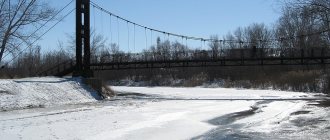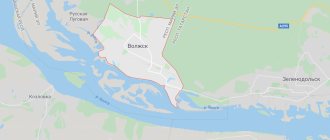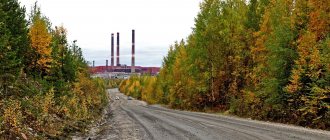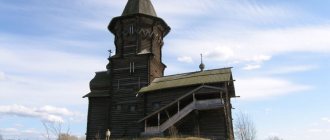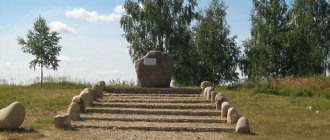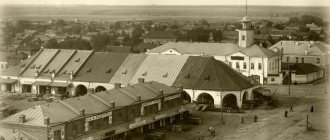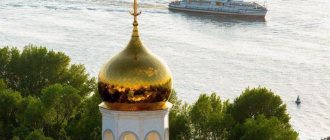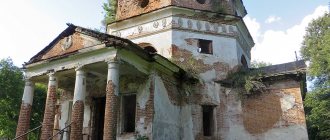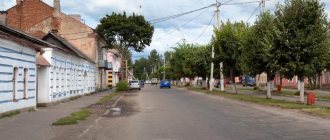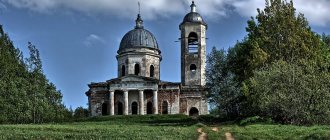Echoes of history and significance for the country
The first mentions of Okulovka date back to chronicles from 1495, and archaeological excavations have shown that ancient Russians began to settle in these territories already in the third millennium BC. These places became a stronghold for monasteries. Some of the wooden churches built in the seventeenth century have survived to this day. Therefore, the city can safely celebrate its five hundredth anniversary, although it was officially founded in 1965.
The population of Okulovka does not exceed eleven thousand people, but this does not prevent the city from making its significant contribution to the economic development of Russia. The Borovenkovo hydroelectric power station, built at the beginning of the twentieth century, supplies electricity to over one hundred and twenty district settlements. The economic potential of the city is determined by twenty industrial enterprises. The cultural development of the population is facilitated by the presence of music schools, libraries, and cultural centers.
Wealth of attractions
Guests of the Okulovsky district arriving from the Moskovskoe highway are greeted by the “Cannon” monument. It is located in the city of Malaya Vishera and was erected in honor of the defeat of the fascist invaders, in memory of the fallen soldiers of the fifty-second army.
The small chapel, named after Varlaam Khutynsky, is considered a holy place and attracts Orthodox people from all over Russia. Another monument to the history of Christianity in Okulovka is considered to be the picturesque Lake Peretno, located just ten kilometers from the city.
Those who want to learn more about the region are invited to visit the Miklouho-Maclay Museum of Local Lore. Natural science collections and exhibitions of objects of the district nobility and peasantry will reveal the historical secrets of these places.
Several monuments have been erected in Okulovka, including to fairly young heroes who have become legends, such as Viktor Tsoi. Like any other city, it is impossible to imagine Okulovka without a monument to the leader of the revolution, Vladimir Ilyich Lenin.
Travel to the city of Okulovka. Few people know what beauties the Novgorod land conceals.
We were brought to Okulovka for an unusual reason. The fact is that my friend Artyom and I are big fans of railways. And we especially love small railway lines that branch off from major highways and go into the wilderness. For the sake of travel on such quiet small railway lines, we come up with different trips from time to time. Last year we went to Borovichi to get acquainted with the short line Borovichi - Uglovka, this year we decided to take a ride on another quiet line - Okulovka - Nebolchi. The train runs there only once a week, and on Tuesdays, which made it difficult to organize a trip, since it is a working day. For a long time I waited for both of us to be completely free on some Tuesday, and in August such an opportunity presented itself. A few more comrades were able to go with us, and so we hit the road. Naturally, since we ended up in Okulovka, we also got to know the city itself. And it turned out to be much more interesting than just a junction station from which a side track departs. First of all, it's cute and cozy. Secondly, the nature there is amazing. I was especially pleased with Okulovskoe Lake - large, with clear and clean water! And few people know these beautiful places, without even realizing what beauties the Novgorod land conceals... Therefore, I will introduce my readers to this Russian town, so that they, too, can someday take a walk here. Or at least get to know him through my photographs. Okulovka station. On the right is the main passage, the road from St. Petersburg to Moscow. In the center there is a path for electric trains. And on the left are the tracks for the very road adjacent to the main route along which trains from Okulovka go to Nebolchi. The photo shows a diesel locomotive with the only trailer that will go there. But you will read more about this in another article, where I will talk about our trip from Okulovka to Kulotino. And now about Okulovka itself, where we spent several hours after returning from Kulotin. It was a hot day and it was necessary to take a swim. Therefore, we went towards Lake Okulovskoye, where one of the local beaches is located. It was possible to go to the river, but as it passed through the city it could no longer be clean, so the lake was a more attractive option. Our path was blocked by a black cat, which had no intention of moving at all; in order to give way to someone, we had to go around it to the left. In general, there are a lot of cats in Okulovka, and that’s good! Wooden house with an apple tree. An incredible amount of apples. There are a lot of them here at every step. Civilization ended suddenly - just 15 minutes after we left the station. The houses and streets ended, wild fields began without a hint of the presence of people. It's awesome to live in a city where wildlife is so close to the city! In the summer the road pleases with flowers, there are plenty of them around. In general, where we walked can be called a road very conditionally. On the map it really looks like a road, but in reality everything that leads in different directions is just trampled grass. It is not recommended to walk here without a navigator if you are not local. Such roads may not appear on other maps. If you get to the lake, it will be through a long path that will lead to the far shore. And we took the shortest route, which took only half an hour. We spent the last five minutes walking through the forest. The forests here are quite as nice as ours on the Karelian Isthmus. And noble mushrooms are present in normal quantities. Here we found a white one right on the road. Before this, many mushrooms had already been collected in another Novgorod corner - Kulotin. We went out to Lake Okulovskoye. It turned out to be quite large. Immediately it started to drizzle, and we didn’t get any good photos because the camera fogged up and there was not enough lighting for the smartphone. But we tried to film it somehow to show you the beauty. On the map this place is marked as a beach. But the beach itself is a small entry into the water along the sand and a clearing next to it. Very modest. On the other hand, it is beautiful and cozy. On a Tuesday in the summer there is not a soul on the lake, and for a small company everything is perfect here. But I don’t know what it will be like on a weekend if a lot of locals come. That's the whole beach. I really like such places - nature is not spoiled, there is a lot of greenery, there is no garbage, there are no fire pits at every turn. And at the same time it is very pleasant to swim, because the bottom is sandy, smooth, there is no grass or stones. It’s simply a miracle that nature has been so well preserved near the city! Locals don’t spoil it, and strangers don’t come here to spoil it. And if anyone comes after reading my blog, it will be those who come for beauty, and they will not be able to disturb it. The lake is lucky - it is far from major roads, an evil kebab-maker in a car will not get here. Beauty! And all this is so close to the station, from the city! Incredible! Forest edge near the beach. I was also surprised to see large schools of fish swimming along the beach. They didn’t allow themselves to be photographed, but there were really a lot of them. This is what I managed to photograph - two roach, but in reality there were dozens of roach and perch. The lake is very fishy. The main advantage of the lake is very clean and transparent water! The same as in the best lakes of the Leningrad region! I didn’t expect to find such clear water in these parts; I thought there were lakes only with swampy water. To record the clarity of the water, we take a couple of underwater photos. And this is the author of the blog. Visibility underwater is excellent! The lake is magnificent! Let's go back. There's time to take a closer look at the houses. The main type of buildings are small wooden houses, next to which there is an area enclosed by a fence. Okulovka is very reminiscent of a village. It has been a rural settlement for almost its entire history; it received city status only in 1964. The population now is about 10 thousand people. On the fence, a cat is washing itself with an important air. Unfortunately, a significant part of the city's houses are boarded up. And many of them are already completely dead. When Okulovka became a city, 20 thousand people lived here, now the population is half that, and this process continues. Here, in one frame, there is both a dead house and an unfinished house. City intersection near the station. It should be noted that the initial gloomy impression of the dead houses quickly disappears, because the atmosphere in the city is somehow spiritual and peaceful. The people are all calm, smiling, willing to give advice if you don’t know something, and greet tourists warmly. We saw the same thing in other places in the Okulovsky district. No sadness is felt in them, they love their land, and they are not sad here. This sharply distinguishes the Novgorod region from the Pskov region, where even in the main city of the region everyone has melancholy and hopelessness on their faces. Everything I described above is expressed in the writing on the wall. For every dark night there is a bright day, it says here. This probably conveys what the residents of Okulovka live with. By the way, while walking around the city, I didn’t come across obscene words on the walls (take a walk in Luga in our region - you’ll see a three-letter word there many times a day), but I saw a lot of all sorts of philosophical statements, as well as quotes from poems by famous poets. And here they listen to Tupac Shakur, as can be seen in the same photo - and I also support this. There are no monuments to politicians, leaders, or generals on the main square, as is most often the case in many cities. Not a single monument to bloodsuckers. Everyone who stands here is a cultural or scientific figure. And that's great. This is my ideal - for monuments to stand just like this! The main character here, of course, is Miklouho-Maclay. The famous Russian ethnographer and traveler was born in Okulovka. There is a museum dedicated to him, and ethnography conferences are held here. Near the monument there is a park with benches where it is pleasant to sit and relax. There are no dead houses here anymore, everything is more or less alive and well-maintained. Again, I will note a feature of the Novgorod region, which I have been writing about for years: there is almost no garbage here, the streets are clean and tidy. And people are good-natured, even if they are drunk.
Large residential building near the station. Wood. There are few stone houses here. Here is one of the stone houses. Ancient, with unusual architecture. Pay attention to the unusual windows. The plaque reports that the Russian scientist Yuri Roerich, son of the artist Nicholas Roerich, was born in this house. He was also an ethnographer and traveler. Very close you can see a monument to the scientist. The square in front of the station. An old wooden house opposite the station. Alley along the railway. Everything is very beautiful and cozy. The old Okulovka station, unfortunately, has not survived; it was demolished several years ago, which was a great barbarity on the part of Russian Railways. At the station there is only this railway building. Okulovsky district is distinguished by great patriotism. At the station there is a stand listing the attractions, and there is a website on the Internet with their detailed descriptions. You won't find anything like this in many places. People here love their area very much and are in a hurry to tell everyone about it. I support them in this endeavor, so I will also write about their attractions. Near the station there is a monument to Viktor Tsoi, by which most people remember Okulovka. So, three monuments: one to an artist, two to scientists. And this is good! Why there is a monument to Tsoi, who is a St. Petersburg character, stands here, it is not very clear. There is a legend that once he was traveling somewhere through Okulovka. That's all. I think that the point is simply that here they love his work just as much as here in St. Petersburg. And this also speaks well about Okulovka. Russian rock is alive, hurray! Well, now let's go look at the ancient church located at the end of the square. This is the Church of Alexander Nevsky. It took us a while to figure out how to get past the fence that encloses the temple, but a local woman immediately rushed to tell us how to get around the fence. I repeat once again that the locals here are friendly and helpful. By the way, not far from the church there is a pie shop where you can find delicious and inexpensive pies. It is interesting that the temple began to be built in the name of St. Nicholas, but was eventually consecrated in honor of Prince Alexander Nevsky. Local merchant Ivan Zubov donated a significant amount for the construction of the temple. The temple was built in 1901, under Emperor Nicholas II. In 1937, Stalin began a real massacre among priests, exterminating almost all of the clergy in Russia. Temples were closed en masse throughout the country. This church was also closed. They made a cinema inside. The height of the bell tower is 12 fathoms, which in modern units of measurement would be 25.6 m. Therefore, it is clearly visible from afar. In 1993, the dilapidated temple was returned to believers. Gradually it regained its blooming appearance. Before the revolution, an almshouse was built near the temple, where a dozen and a half old women and old men lived out their lives and were cared for there. At that time, churches often engaged in charitable activities. Beautiful bell tower. Monument to the victims of political repression. In small towns, those killed by communist executioners are well remembered. And this memory should not disappear so that this never happens again. On the other hand, they remember the liquidators of the Chernobyl accident. Beautiful temple! I went to the station. I met only one worker inside, and he was sleeping with his head on his paw. There is no one at the frames at the entrance to the station building, and this makes me happy. At least here they don’t spoil people’s mood by simulating concerns about safety. The waiting room is small. But there is a coffee machine and toilets, so the station is comfortable. A year ago we were at a similar Uglovka station - it was just empty, no waiting room, no service, but there were guards. Here it's the other way around, and it's nice. Let's go to our train. We return to St. Petersburg by two different “Swallows” - one on the “Swallow” from Bologoe, the other on the Moscow one. On the way we make a stop in Malaya Vishera. And there I photograph the old station. There was once a similar one in Okulovka.
Original
Interesting Facts
The city left an important mark on archaeological science, thanks to the works of Nicholas Roerich. His discoveries replenished the Golden Fund of the Russian Archaeological Society. Here his son Yuri was born, who became a famous traveler and ethnographer.
Okulovka became the prototype of the famous rural landscapes of Isaac Levitan. He captured local beauty in the films “Twilight”, “Summer Evening”, “Huts”, “Last Rays of the Sun”. From the pen of Nikolai Rimsky-Korsakov the opera “Kashchei the Immortal” and “The Tale of the City of Kitezh” came out. The author worked in Okulovka from 1901 to 1903.
The famous poetess Olga Berggolts was impressed by the nature of the Okulovsky region. And after visiting this wonderful land, I wrote the book “Day Stars”. The clean air of these places and natural beauty were appreciated and sung by poets Nikolai Gumilyov, Mikhail Kuzmin, Sergei Auslender.
Map
| Okulovka: maps |
Okulovka: photo from space (Google Maps) Okulovka: photo from space (Microsoft Virtual Earth)
| Okulovka. Nearest cities. Distances in km. on the map (in brackets along roads) + direction. Using the hyperlink in the distance , you can get the route (information courtesy of the AutoTransInfo website) | |||
| 1 | Borovichi | 35 (37) | IN |
| 2 | Valdai | 45 (104) | YU |
| 3 | Sacrum | 47 (51) | Z |
| 4 | Lyubytino | 49 (98) | WITH |
| 5 | Ozerny (Tver region) | 61 () | YU |
| 6 | Bologoe | 70 (150) | SE |
| 7 | Moshenskoye | 76 (90) | IN |
| 8 | Malaya Vishera | 82 (187) | NW |
| 9 | Coniferous | 90 (118) | NE |
| 10 | Proletarian | 93 () | Z |
| 11 | Demyansk | 95 (147) | SW |
| 12 | Firovo (Tver region) | 101 () | YU |
| 13 | Parfino | 106 (166) | SW |
| 14 | Udomlya | 114 (227) | SE |
| 15 | Vyshny Volochyok | 115 (176) | SE |
| 16 | Velikiy Novgorod | 118 (133) | Z |
a brief description of
Located on the Valdai Hills, on the river. Peretna (Msta basin), 140 km east of Veliky Novgorod. Railway station.
Near Okulovka is Valdai National Park.
Territory (sq. km): 31
Information about the city of Okulovka on the Russian Wikipedia site
Historical sketch
It arose as a village at the Okulovka station (opened in 1851); name after the village of Okulovka. Oikonym from the very common nickname Okul (“rogue, braggart, deceiver”). In 1856, one of the oldest pulp and paper mills in Russia was founded.
Workers' settlement Okulovka from June 25, 1928
On January 12, 1965, the decision was approved to merge the working settlements of Okulovka (7.7 thousand inhabitants, 1959) and Parakhino-Poddubye (PGT from 06/25/1928, 6.4 thousand inhabitants, 1926; 7.4 thousand inhabitants, 1931; 11.4 thousand inhabitants, 1939; 12.4 thousand inhabitants, 1959) to the city of Okulovka.
Economy
In Okulovka: a paper mill (founded in 1856), a radio components plant, a mineral water bottling plant. Production of building materials.
In the Okulovsky district flax, potatoes, and grain crops are grown. Dairy farming.
Deposits of construction sands and clays. Mineral water sources.
Main enterprises
ELECTRONICS INDUSTRY
OJSC "Agrokabel"
174350, Novgorod region, Okulovsky district, Okulovka, st.
Titova, 17 Offers:
Cable and wire products
WOOD PROCESSING INDUSTRY
OJSC "Okulovsky wallet"
174350, Novgorod region, Okulovsky district, Okulovka, st.
Central, 5 Offers:
Mouthpiece paper, wallpaper
LIGHT INDUSTRY
OJSC "Kulotinskaya Manufactory"
174710, Novgorod region, Okulovsky district, urban settlement Kulotino, Sovetsky Ave., 1
Offers:
Packaging bags
Culture, science, education
Orientalist Yu.N. was born in Okulovka. Roerich, son of the artist N.K. Roerich.
Architecture, sights
Buildings of the railway station and depot (1850), former houses of Soin and Zubov (late 19th century), etc.
25 km southeast of Okulovka, in the village of Yazykovo-Rozhdestvenskiye, there is St. George’s Church (1801), the former estate where N.N. was born. Miklukho Maclay.
| Population by year (thousands of inhabitants) | |||||||
| 1926 | 2.9 | 1992 | 16.9 | 2007 | 13.1 | 2016 | 10.7 |
| 1931 | 3.4 | 1996 | 16.4 | 2008 | 12.8 | 2017 | 10.5 |
| 1939 | 5.5 | 1998 | 16.4 | 2010 | 12.2 | 2018 | 10.3 |
| 1959 | 7.7 | 2000 | 15.5 | 2011 | 12.5 | 2019 | 10.0 |
| 1967 | 20 | 2001 | 15.2 | 2012 | 11.9 | 2020 | 9.8 |
| 1970 | 19.2 | 2003 | 14.5 | 2013 | 11.6 | 2021 | 9.5 |
| 1979 | 19.3 | 2005 | 13.7 | 2014 | 11.3 | ||
| 1989 | 17.2 | 2006 | 13.4 | 2015 | 11.1 | ||

